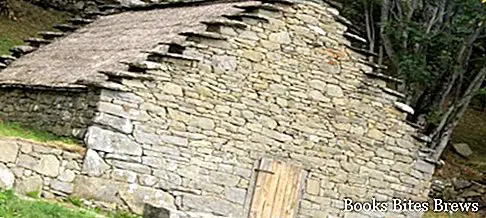What to see in Fiumalbo, itinerary including the main places of interest in the village, including the main square with the Church of San Bartolomeo and the Celtic huts in the surrounding area, as well as naturalistic excursions.
Tourist information
Located in the province of Modena in the Frignano Park, Fiumalbo is one of the most beautiful villages in Italy.
The origins of the village are very ancient, as evidenced by the rural buildings present, dating back to the fourth century BC, built therefore at the time of the Celts.
These buildings consist of rectangular stone houses, covered in some cases with thatched roofs, while in others they include a stepped sandstone roof, with an appearance of the overall structure very similar to buildings of the same type found in Ireland and Scotland.
The name Fiumalbo indicates the sparkling waters of the streams that cross the area.
The historic center has retained the typical appearance of the medieval village, with its stone houses overlooking uneven streets, where ups and downs alternate.
In the main square of Fiumalbo there is the church of San Bartolomeo Apostolo, dating back to 1220 but rebuilt in 1592, using different material recovered from the previous church, of which various fragments can still be observed.
The current church is oriented differently than the original one and includes a beautiful portal on the left side, which has become a facade, the central nave has a coffered ceiling and the side chapels are enriched by altars of considerable artistic value.
In addition, inside there are stone fragments of the Romanesque age, as well as two sixteenth-century panels representing respectively the Madonna with the Saints, by Saccaccini, and the Redeemer, a masterpiece created by the Tuscan school.
In the apse you can admire the beautiful canvas depicting the Martyrdom of San Bartolomeo, a work from 1837 created by Adeodato Malatesta.
Very interesting are the sacred furnishings and the silverware preserved in the place of worship, including the cross of Fiumalbo, a work of 1494 made of silver foil by the goldsmiths Antonio and Jacopo da Porto, a small statue of the Madonna in silver by Borroni, and a silver cross from 1747.
Recommended readings- Brisighella (Emilia Romagna): what to see
- Grazzano Visconti (Emilia Romagna): what to see
- Castelnovo ne ’Monti (Emilia Romagna): what to see
- Canossa (Emilia Romagna): what to see
- Emilia Romagna: Sunday day trips
What see
The Church of the Immaculate Conception, also known as the White Church because it is the seat of the homonymous brotherhood, has a stone facade that incorporates the portal of the previous church on which it was built.
The classroom interior includes a large barrel vault, a sixteenth-century canvas of the coronation of the Virgin, an eighteenth-century banner for procession, painted on both sides, the nineteenth-century altar and the organ.
The church of Santa Caterina, dating back to 1601, houses inside a museum of sacred art where, among the main works include the panel depicting the Madonna and Child Enthroned, painted by Sacaccino Sacaccini, and a sixteenth-century painting which has as its subject the Last Supper, previously placed to decorate the monastery of the Dominican nuns.
The Oratory of San Rocco, which dates back to 1418 and is located at the beginning of the village, has an interior where there are decorations by the artist Saccaccini, made in 1535, also the construction features are typical of the Tuscan Renaissance, with interior cruise and earthenware floor.
Starting from Fiumalbo, during the winter season it is possible to reach Val di Luce with snowshoes, venture out on trekking routes with snowshoes and go on snowmobile or mountain bike tours on the snow.
Fishing enthusiasts can practice this activity by respecting the rules, including the one that prohibits capturing and retaining protected species caught in streams and ponds in the area.
In summer it is possible to stay in the various farmhouses scattered around the area, to rest immersed in nature and to get to know the local traditions directly.
The events include the feast of San Bartolomeo, patron saint of the town, which takes place on August 24 and during which stalls are set up located in the streets of the center, with the game of bingo at the end of the event.
The procession takes place on the eve of the feast, with which the statue of the saint is transported, followed by the ancient Confraternities of the Whites and Reds with their traditional costumes and banners.
On this occasion, the town lights up with torches and candles and, also including the course on the river, the overall effect is very suggestive.
The famous Crunchy of Fiumalbo is produced in the pastry shops of the historic center of Fiumalbo, made following a particular local recipe that has been handed down for many generations, characterized by simple ingredients including honey, almonds, sugar and caramel.
In the vicinity of Fiumalbo, in the locality of Doccia and in the village of the Valdare, there are the Celtic Huts, which consist of rural stone buildings characterized by particular stepped facades and covered with sandstone slabs.
From Foce to Giovo, which is a pass located between Monte Femminamorta and Monte Borra located ten kilometers from Fiumalbo, passes the Strada del Duca, along which there are various basins created by glaciers that, filling with water, form small lakes with particularly clear water.




